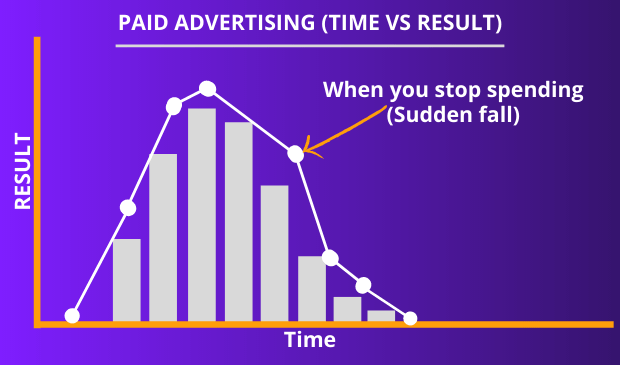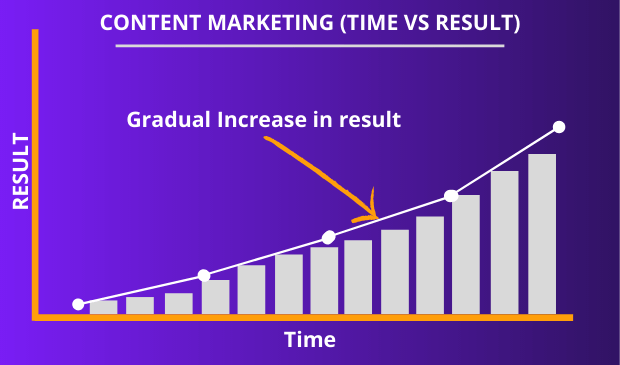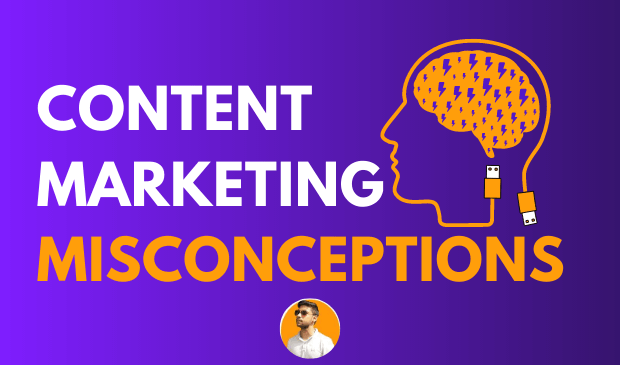Even though content marketing is not a new marketing technique, people often make misconceptions about it.
Why are busting content marketing misconceptions so essential for you too?
The main reason is to make sure you’re on the right track.
And, When you’re on the right track, you know:
- What results to expect
- How to achieve that result
- What tasks to perform
- How long to wait to achieve those results
In this blog post, I will bust your 9 most common and vital misconceptions about content marketing.
In case this is your first time here, let me introduce myself.
I am Rafiqul, a content marketing practitioner, and welcome to my blog.
Content marketing is all about blogging and SEO
“Every blogging strategy can be a part of content marketing, but not all content marketing strategies are part of blogging”.
The same holds for SEO.
It makes me curious when people consider implementing content marketing as starting a blog and optimize it for SEO.
Yes, blogging is super crucial in many cases, but it isn’t all that you can think of as a content marketer.
I tried to find why this misconception is so strong among the people?
All I could understand is that people are still not sure about what content marketing actually is.
It’s like when blind people can touch, feel a piece of bread but still not able to figure out what it is.
We all are creating and promoting content, yet only a few people have understood this.
To bust this myth, let’s understand what it is.
“Content marketing is a strategic way of creating and distributing useful, relevant, and compelling content to attract, engage, and nurture loyal audience at the right time to achieve business goals (sales, leads, awareness, etc.)”.
Now after reading this definition, tell me:
- Are blogging and SEO are the only two ways of doing this?
- Can’t we create Educational video content?
- Isn’t the ‘about us’ page of your blog a piece of content?
- Ideas are endless when you think in the right way.
Key Takeaways
- The next time, you think of implementing content marketing, don’t restrict yourself to just SEO, blogging.
- Anything that can satisfy the above definition can be considered as a great piece of content.
- Start thinking on a broader scale.
Creating content is enough to be successful at content marketing
Just like the above myth, this one is also related to the core definition of content marketing.
Since you already know what it actually is, I will try to explain the step-by-step process of making content marketing successful.
So the answer to this misconception is No, creating only content is not enough.
From making a strong strategy to implement it with consistent, useful, and relevant content and also measure it with the right KPIs, all are equally important.
To make it more specific, let’s dive right into the necessary steps that make the real difference.
- DOCUMENTING the Content Marketing strategy
- Setting the right GOAL.
- Selecting the right CONTENT FORMAT
- Understanding your CUSTOMERS
- Preparing CONTENT STRATEGY
- Creating an editorial CONTENT CALENDAR
- Creating CONTENT
- Content REPURPOSING
- DISTRIBUTING AND PROMOTING content
- MEASURING Content ROI
You see content creation is just a part of many. It will be reasonably unfair if you just avoid the rest of them and consider only creating content.
Creating content just for the sake of it doesn’t help you much in this.
Many marketers focus so much on creating content that they never use a documented content strategy.
But when you document your content marketing strategy, you’re much more likely to succeed, as per the CMI study.
(Link: https://contentmarketinginstitute.com/research/)
“Stop creating and finish documenting your content marketing strategy”- Joe Pulizzi.
Key takeaways
- Achieving your business goal with content marketing is not only dependent on content creation.
- Start documenting your strategy, goal, content calendar, and effectiveness.
Content Marketing is another type of Paid advertising
I haven’t seen this myth frequently, but I found that it is a critical point to discuss after seeing this.

Not most of the people, but many marketers are still trying to understand the difference between these two.
Let’s break the myth.
The goal of both Content marketing and paid advertising could be the same, but the nature of working is quite different.
[Not to forget that I am talking about only about the organic method for content marketing]
For example, you may want to generate leads for your business. For that purpose, you’re running a paid Ad campaign.
During the campaign, you’ll capture many leads, but the moment you stop spending money, the leads will automatically stop coming.
No matter whatever is your goal, you may find a similar graph like the following for paid advertising.

As you can see the moment you stop investing money, the spike also gets disappeared.
On the other hand, the graph for the same in content marketing looks like this.

It takes time in the initial stage, but when applied with proper strategy, you’ll see a gradual improvement in terms of getting leads over time.
Therefore by nature, both of these are entirely different from each other.
Again, don’t conclude that one is better than the other one.
It’s about the understanding of the fundamental differences that’ll help you implement in better ways.
Key takeaways:
- Marketing content is just like wine that gets better with age.
Content marketing is great to get a short-term result
“If you need immediate results with your marketing, do not do content marketing. Go interrupt people. Go buy advertising”
Joe Pulizzi
The number one reason is building, creating, and nurturing the right audience cannot happen in the short term.
You can get leads by interrupting people (buying ads), but you won’t see much-qualified leads.
But when it comes to content marketing, most of the leads will be qualified and already a part of the loyal audience.
It’s because you’re not interrupting people to get leads; instead, you’re either educating or providing useful content to your audience to capture leads.
In one of Joe Pulizzi’s book, Content Inc, he mentioned that one should invest 15 to 17 months of consistent content creation and distribution to get real results.
Key takeaway
- Always have a mindset of continuing for the long term instead of 6 to 9 months of the window.
- Again, if getting the immediate result is your first priority, then you might choose other alternatives to content marketing.
The ultimate goal of content marketing is about generating more revenue
No, it isn’t.
Generating more sales and leads might be a goal to achieve, but it is not the ultimate one.
The end goal is more related to the audience than the profit.
Remember the definition that I mentioned in the first point. You’ll see the term ‘loyal audience’.
What do I mean by that?
In a word, it is about building trust.
And trust is the core part of building a loyal audience.
Building trust by interrupting through paid Ads is super hard, especially when the prospect knows nothing about the brand.
In the case of content marketing, your goal might be to generate more sales and leads or any other.
But it is not the ultimate goal even though trust alone is not enough to run a company.
What you need to understand that when you consider your end goal to build a loyal community that trusts your brand, you can have multiple monetization ways.
To do that you need to create content to help people not to get your sale.
This is why it takes much time to make someone trust your brand from knowing nothing about your brand.
The moment you start focusing on serving your audience first and getting revenue second, you can easily build a community that likes you, knows you, and most importantly trust you.

Key takeaways
- Start helping your audience selflessly.
- Focus on building a loyal audience first and monetization second.
- Don’t try to sell your product or service through each of your content.
- Instead, focus on the buyer’s journey and introduce your product or services only when it is relevant to the content and buyer’s journey.
“People consume content, and then they just buy from you”
You’ve followed every element discussed in the second misconception of this article.
Now you might think of getting results through content marketing like this:
Someone visits my blog, read the content, started liking my article, visited the ‘about us’ page of my website, then looking for the product or services that I offer, and next to that person finally buys from me.”
That is absolutely wrong.
If this was your belief about how content marketing does work, then it’s time to redefine it.
Rand Fishkin has explained the working principle with the following example:
In a football game where after hundreds of successful passes, one player scores a goal.
Yes, only one touch from a player leads to the goal, but that doesn’t mean all of the passes played before that are ineffective.
In fact, only because of those passes, one can get to a position to score.
Likewise, in content marketing, one needs to deliver relevant, valuable (successful) content multiple times to a prospect before they know you and trust you.
Even after trusting your brand isn’t enough to get sales.
Maybe the person currently doesn’t need the product or service that you’re offering.
But the moment there is any need for that, that prospect might think about your brand.
And that is when you get a sale.
It’s not just about someone is consuming your content and therefore going to buy from you.
The study of Moz shows that on average, someone visits Moz’s blog 7.5 times before they sign up for the free trial of their software.
Key takeaways
- You need to understand that people need to interact with your content many times before they decide to buy from you.
- Study your buyer’s journey and create content for each of the buyer’s stages.
- Never expect results too early.
- Nurturing your leads is as important (if not more) as acquiring leads.
We cannot measure the ROI
It is a fact that only 21% of B2B marketers were successful at measuring content marketing ROI, according to the study of CMI.
The reason behind this poor number is not because of ROI measurement is impossible, but many of them make mistakes regarding the KPI.
Three common mistakes are:
- Focusing on too many KPIs
- Not aligning the metrics with the goal
- Wrong expectations

Here’s the complete guide to measuring ROI that breaks this misconception.
Content is liability
Before I justify why is this a misconception, let me share a real-life example.
Unbounce, a software company started building the right audience one year before launching its first product. As a result, by the time, they launched their software, their blog was already getting 20k unique visitors/month.
The CEO of Unbounce once said that “If we had not started blogging at the beginning the way we did, Unbounce would not be here today… our content still drives customers. Something we wrote in January 2010 still drives customers today…”
Again, let’s have a look at the definition of Asset (source: Wikipedia)
Now, here is my question for you.
What will you call something that is giving you return (profit) even after many many years of creating that?
It is an Asset (At least from the definition, we can easily say this).
Treating content as an asset will encourage you to make it super valuable and relevant to your audience.
Key takeaways
- The content you’re producing today is going to stay for years, and if it is good enough, it will drive customers in the future as well.
- Never try to compromise the quality of your content.
- Evergreen content will drive the most benefits. Keep updating or removing the irrelevant and old content.
Content marketing is for everyone
Without knowing much about its nature, potential, and requirement, many businesses start investing in creating and promoting the content.
It might bring some exceptional results but not many.
Let’s first clear the fact that content marketing isn’t for every business.
But it is also a valid question of how one can identify whether it is the right fit for their business or not.
You’re already doing this to some extent. To take it seriously you need to answer the following questions.
- Are you ready for a long term (at least 15 to 17 months) investment?
- Can you provide quality (useful, relevant, and valuable) content consistently for a long time?
- Are you ready to keep going even after getting a negative ROI in the beginning?
- Do you have all (resource, budget, skills, etc.) to make it happen?
If your answer is ‘Yes’ for each of the above questions, then it might be the right fit for you.
Key takeaways
- Start by evaluating whether it is the best-fit solution for you or not.
- Never begin with content marketing, when you’re not ready to invest at least next 12 months.
- Even negative ROI, in the beginning, is not the endpoint. In most cases, you’re not going to see such significant a result in the initial stage.
Final words
It is always better to learn the basics first, especially when the learning is related to your business goals.
This is what I have tried to do by busting 9 crucial content marketing misconceptions.
That’s all.
If you feel I have left any crucial myth in this article, please let me know in the comment.

Sk Rafiqul Islam is a content marketing practitioner with 3+ years of practical experience. He spends most of his time helping businesses to build a loyal audience with content marketing. He is also running a tech career blog called 10Pie and content marketing VIP, a bi-weekly marketing newsletter. In his free time, he loves reading books and playing football.
